Isn't it a coincidence that just when you decide to take your motorcycle out for a long ride, you notice a drip on the ground? You might brush it off, but that small leak could lead to bigger problems if you don't act. Identifying the symptoms of an oil leak is essential for keeping your bike in good shape. From unusual engine noises to oil stains, knowing what to look for can save you time and money. Curious about what signs you should watch for next?
Key Takeaways
- Common oil leak sources include the oil filter, oil pan, gaskets, and oil lines that need regular inspection for damage or wear.
- Look for visual indicators like wet residue on the engine or ground and frequent drops in oil levels.
- Monitor oil color changes; fresh oil is amber, while dark or milky oil signals potential issues needing immediate attention.
- Unusual engine noises, smoke, or vibrations may indicate insufficient lubrication from leaks, affecting performance and safety.
Understanding Oil Leak Sources
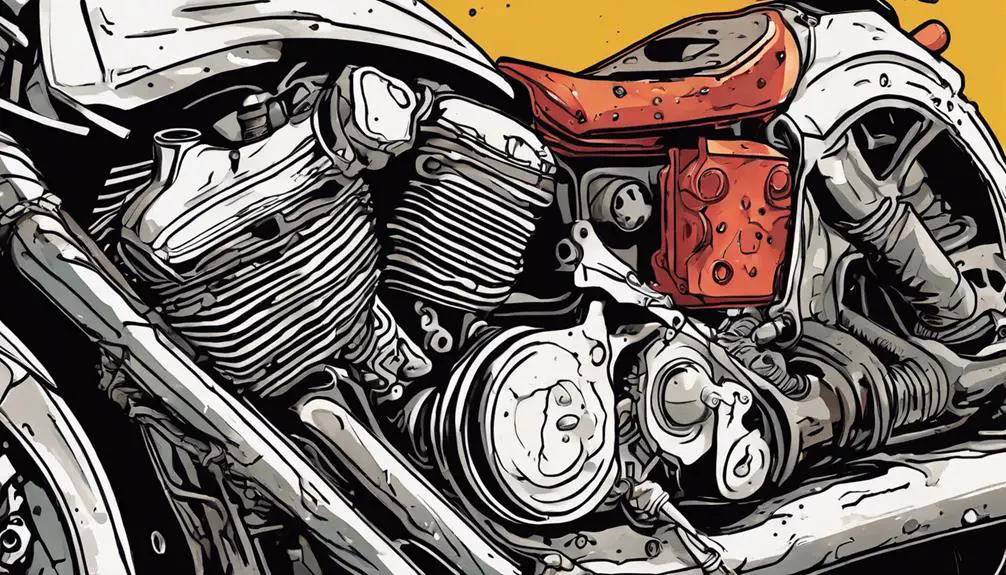
Motorcycle oil leaks can stem from several common sources, so it's crucial to identify where the problem might be coming from. You might notice oil pooling under your bike or a drop of oil on your garage floor. Don't ignore these signs; they could lead to bigger issues down the road.
First, check your oil filter. If it's loose or damaged, oil can escape and create a mess.
Next, inspect the oil pan. A cracked or improperly sealed oil pan can leak oil, compromising your ride's performance.
Also, look at the gaskets and seals. Over time, they can wear out, leading to leaks that steal your freedom on the open road.
Don't forget to examine the oil lines and hoses. Any cracks or abrasions can lead to leaks that inhibit your bike's capabilities.
Your motorcycle's health relies on you staying vigilant. By understanding these common sources of oil leaks, you empower yourself to take action.
Fixing these issues not only protects your bike but also liberates you from the worry of breakdowns. Embrace the road ahead with confidence!
Common Ducati Oil Leak Locations
Ducatis, with their unique engineering, often show oil leaks at specific locations that you should check regularly. Knowing where to look can save you from the frustration of unexpected spills and keep your ride smooth and liberating.
Here are the common leak spots you shouldn't overlook:
- Oil Filter Area: Check for loose fittings or damaged seals that can cause oil to escape.
- Crankcase Seals: These seals can wear down over time, leading to leaks that can affect performance.
- Valve Cover Gasket: A worn or improperly installed gasket can lead to oil seeping out, creating a mess and potential hazards.
Symptoms of Oil Leaks
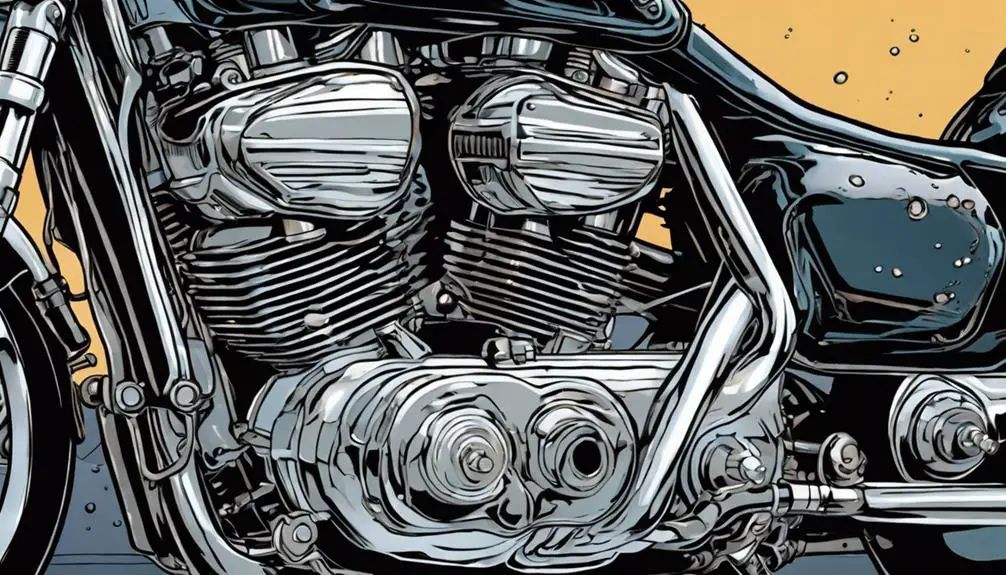
You may often notice some telltale signs that indicate your bike is leaking oil, which can compromise its performance and safety. One of the first symptoms you might see is a wet or oily residue on the engine or the ground beneath your bike. This isn't just a cosmetic issue; it's a signal that something's off, and it needs your attention.
Another symptom is a drop in oil levels. If you find yourself needing to top off your oil more frequently, your bike could be losing it through a leak. You might also hear unusual engine noises, which can arise when the oil level dips too low, compromising lubrication.
Additionally, keep an eye out for smoke or burning smells while riding. This can indicate that oil is leaking onto hot engine components, creating hazardous conditions that can affect your ride.
Feeling vibrations or noticing changes in handling can also signal that your bike's performance is being affected by an oil leak. Trust your instincts—if something feels off or looks different, it's time to investigate further. Your freedom on the road depends on a well-maintained ride.
Checking for Oil Spots
When checking for oil spots, start by looking in common areas like under the engine and near the oil filter.
You'll want to assess the size of the spots to gauge the severity of the leak.
Also, take note of the fluid color, as it can help you identify whether it's engine oil or another type of fluid.
Common Oil Spot Locations
Checking for oil spots can help you pinpoint the source of a leak and prevent further damage to your motorcycle. When you notice oil on the ground, it's vital to investigate common locations where leaks often occur. Understanding these spots not only protects your ride but also liberates you from the worry of unexpected breakdowns.
- Engine casing: A cracked casing can lead to a serious leak and a hefty repair bill.
- Oil filter: If it's not tightened properly, it can drip oil, signaling a quick fix.
- Oil drain plug: Verify it's secure; a loose plug can create a puddle under your ride.
Assessing Spot Size
Evaluating the size of oil spots can reveal the severity of a leak and guide your next steps for repairs.
When you spot oil under your motorcycle, take a moment to measure it. Small spots, about the size of a quarter, usually indicate minor leaks that mightn't require immediate attention. However, if the spots are larger, like a dinner plate, you're facing a more significant issue that needs prompt action to prevent damage and guarantee your freedom on the road.
To assess the spots, check their diameter and note how quickly they accumulate. If the oil pool expands rapidly, it signals a more severe problem that demands your attention.
Don't ignore it; every droplet could lead to bigger issues down the line.
Identifying Fluid Color
Identifying the color of the fluid pooled under your motorcycle can help you determine whether it's engine oil or another type of leak. This step is essential for maintaining your freedom on the road. The fluid's hue can tell you a lot about the problem at hand.
Here's what to look for:
- Black or dark brown: This often indicates old engine oil that needs changing.
- Amber or golden: Fresh engine oil; if you see this, you're in good shape.
- Red or pink: Transmission fluid; if this leaks, it could lead to serious issues.
Engine Performance Indicators
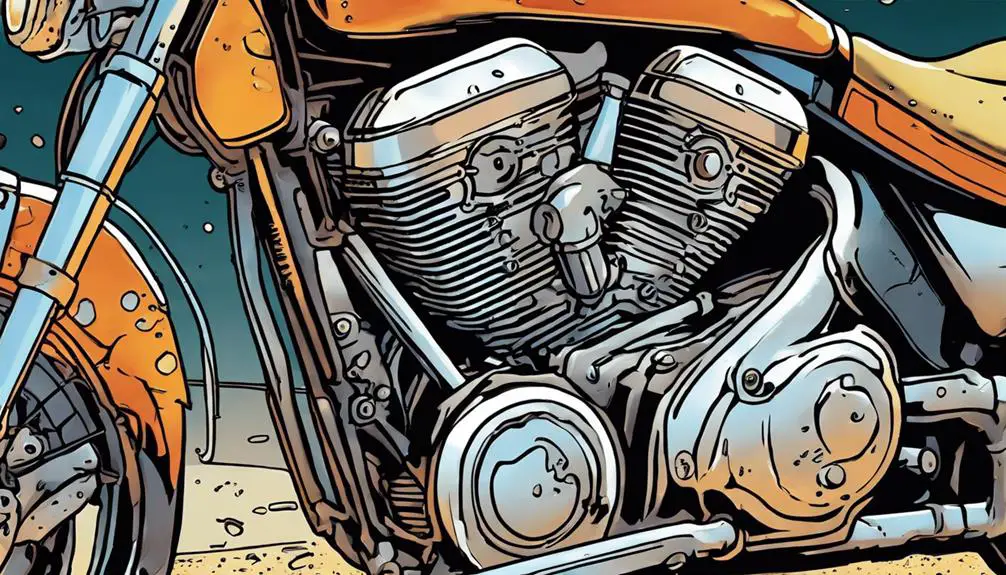
Noticing a sudden drop in engine performance can signal potential oil leaks in your motorcycle. When you feel your bike struggling to accelerate or experience a rough idle, it's a clear call to action. An oil leak can lead to insufficient lubrication, causing friction that robs your engine of power.
Pay attention to any unusual noises, like knocking or tapping sounds, which may indicate that your engine isn't getting the oil it needs. You might also notice a decrease in fuel efficiency; if you're filling up more often without changing your riding habits, it could be a sign.
Additionally, if your motorcycle feels sluggish or unresponsive, it might be due to low oil levels affecting combustion. These performance shifts aren't just minor inconveniences; they can compromise your freedom on the road.
Don't ignore the signs. Trust your instincts and investigate. Monitoring these engine performance indicators can empower you to act before a small issue turns into a costly repair.
Your ride is your liberation; keep it running smoothly and enjoy every twist and turn with confidence.
Inspecting Seals and Gaskets
When you look closely at the seals and gaskets on your motorcycle, you can spot potential sources of oil leaks before they become major issues. These components play an essential role in keeping your ride smooth and powerful. Take a moment to inspect them regularly; it's a small effort that can lead to freedom on the open road.
Here are some signs to watch for during your inspection:
- Cracks or tears that let the oil escape, robbing you of that exhilarating ride.
- Discoloration indicating age or wear, reminding you that your bike deserves better.
- Sticky residue around the seals, a silent cry for attention.
Monitoring Oil Levels
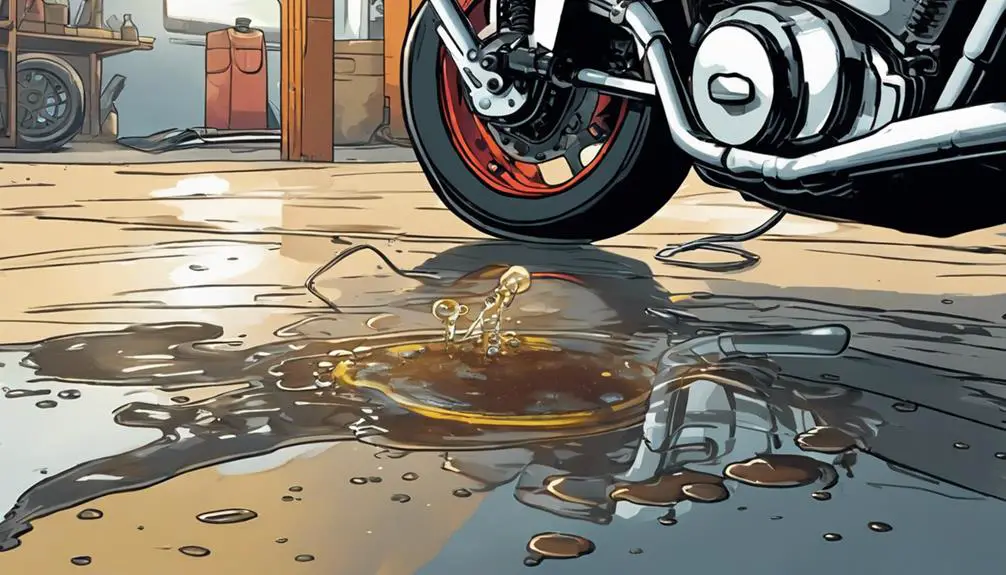
To keep your motorcycle running smoothly, you need to monitor your oil levels regularly.
Checking the oil dipstick, observing any color changes, and evaluating leak locations are key steps in this process.
Checking Oil Dipstick Regularly
Regularly checking your motorcycle's oil dipstick is essential for maintaining peak engine performance and preventing leaks. When you keep an eye on your oil levels, you empower yourself to ride freely without the nagging worry of engine failure. A simple dipstick check can save you from costly repairs and the frustration of unexpected breakdowns.
Here are a few reasons why monitoring your oil levels matters:
- Freedom to Roam: Enjoy the open road without the fear of engine troubles.
- Peace of Mind: Know that your motorcycle is in top shape and ready for adventure.
- Cost Savings: Preventing leaks means fewer repairs and more cash for your next ride.
Take a moment before each ride to check the dipstick. It only takes a few minutes, but the benefits are immense. By embracing this simple habit, you're not just maintaining your bike; you're fueling your passion for exploration and ensuring every journey is smooth and exhilarating.
Ride confidently, knowing you've got your motorcycle's back!
Observing Oil Color Changes
Observing changes in your motorcycle's oil color can provide essential insights into its health and potential leaks. Fresh oil typically has a golden or amber hue, indicating peak performance.
As you ride, keep an eye on this color; if it darkens to a black, muddy shade, it's a sign that your oil is breaking down and may need changing.
Additionally, if you spot a milky or frothy appearance, don't ignore it. This could mean coolant is mixing with your oil, suggesting a serious issue like a blown head gasket.
Regularly checking the oil's color not only helps you maintain your ride but also liberates you from the worry of unexpected breakdowns. You want the freedom of the open road, not the frustration of engine trouble.
If you notice any significant changes, take action! Change your oil or seek professional help.
Assessing Oil Leak Locations
Monitoring your oil levels is key to pinpointing potential leak locations and ensuring your motorcycle runs smoothly. A consistent check can save you from unexpected breakdowns and keep that sense of freedom alive. When you notice your oil level dropping faster than usual, it's time to investigate. Here's how you can assess the situation effectively:
- Feel the thrill of the open road without worry.
- Avoid the frustration of unexpected repairs.
- Experience the joy of maintaining your motorcycle's health.
To start, park your bike on a level surface and let it sit for a few minutes. Check the dipstick and note the oil level. If it's low, inspect common leak areas such as the oil filter, drain plug, and gaskets.
Wipe any oil residue with a clean cloth, then take it for a short ride. Afterward, recheck for fresh leaks. This hands-on approach not only empowers you but also strengthens your bond with your ride.
Stay proactive, and you'll enjoy the liberation that comes with a well-maintained motorcycle.
Importance of Regular Maintenance
Routine maintenance is essential for keeping your motorcycle running smoothly and preventing oil leaks. By taking the time to regularly inspect and service your bike, you not only enhance its performance but also extend its lifespan. You've invested in your freedom on two wheels, so don't let neglect hold you back.
Start with simple tasks like checking your oil levels, tightening any loose bolts, and inspecting gaskets for wear. These small actions can save you from bigger headaches down the road. A well-maintained motorcycle is less likely to develop leaks, ensuring that you can ride without worry.
Pay attention to your bike's changing sounds and handling—these can signal when something needs your attention. Regular oil changes and filter replacements are essential; they keep your engine clean and efficient, which is critical for that exhilarating ride you crave.
Embrace the liberation that comes with knowing your motorcycle is in peak condition. When you take charge of your maintenance, you're not just preserving your ride; you're also fostering a deeper connection with the machine that carries you on your adventures.
When to Seek Professional Help
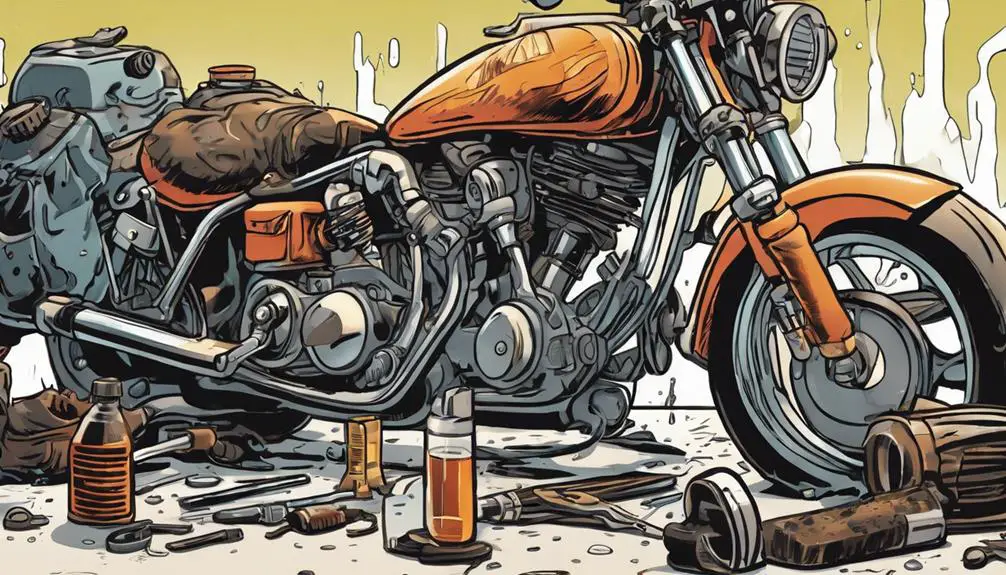
Knowing when to seek professional help can make a significant difference in addressing motorcycle oil leaks effectively. While you might feel empowered to tackle some issues on your own, certain symptoms should raise a red flag. Ignoring these signs could lead to more severe damage and a loss of that exhilarating freedom you crave on the open road.
Consider reaching out to a professional if you notice:
- Consistent oil spots under your bike, threatening your ride's integrity.
- Unusual noises or vibrations during your journey, signaling deeper mechanical problems.
- Rapid oil loss despite regular checks, hinting at a severe underlying issue.
Don't let pride or uncertainty hold you back. Seeking expert help isn't a sign of weakness; it's a step toward ensuring your motorcycle remains your faithful companion.
Frequently Asked Questions
Can Oil Leaks Damage My Motorcycle's Engine Over Time?
Yes, oil leaks can definitely damage your motorcycle's engine over time. If you ignore them, you risk running low on oil, which leads to inadequate lubrication.
This can cause excessive wear and tear on engine components, increasing the chances of costly repairs or even engine failure.
You've got to stay proactive and check for leaks regularly.
Keeping your bike well-maintained guarantees it runs smoothly and safely, giving you the freedom to ride without worry.
How Often Should I Check for Oil Leaks?
Imagine you're cruising down the open road, wind in your hair, freedom all around.
To keep that ride smooth, you should check for oil leaks regularly—ideally every few weeks. If you're hitting the road often or tackling rough terrains, bump it up to weekly.
Staying proactive helps you catch issues early, ensuring your bike runs strong and your adventures continue without a hitch.
Don't let a small leak spoil your journey!
Are Oil Leaks More Common in Older Motorcycles?
Yes, oil leaks are generally more common in older motorcycles.
As bikes age, gaskets and seals wear out, leading to potential leaks.
You might notice this more if you frequently ride your vintage ride, as the wear and tear adds up.
Regular maintenance can help minimize these issues, so keep an eye on those fluid levels.
Embracing your motorcycle's quirks can be part of the adventure, but staying vigilant is key to a smooth ride!
What Materials Are Best for Sealing Oil Leaks?
When you're tackling oil leaks, choosing the right materials can make all the difference.
Rubber gaskets and O-rings are excellent for sealing due to their flexibility and durability.
Silicone sealants are also a great option, providing a strong bond that withstands oil and heat.
Don't forget thread sealants for bolts and fittings; they can prevent leaks before they start.
With the right materials, you'll keep your ride smooth and worry-free.
Does Weather Affect the Likelihood of Oil Leaks?
Yes, weather can definitely affect the likelihood of oil leaks.
Extreme temperatures, whether hot or cold, can cause seals and gaskets to expand or contract, leading to cracks and wear.
When it's rainy or humid, moisture can exacerbate existing issues.
If you're passionate about maintaining your freedom on the road, keep an eye on your bike's condition, especially during changing weather.
Regular checks can help you avoid costly repairs down the line.
Conclusion
To summarize, staying vigilant for oil leak symptoms is key to your motorcycle's health.
By checking for oil spots, monitoring oil levels, and inspecting seals and gaskets, you can catch problems early and prevent costly repairs.
Remember, a well-maintained bike runs smoother, lasts longer, and keeps you safer on the road.
So, keep an eye out, stay proactive, and don't hesitate to seek professional help when needed.
Your ride deserves the best care!